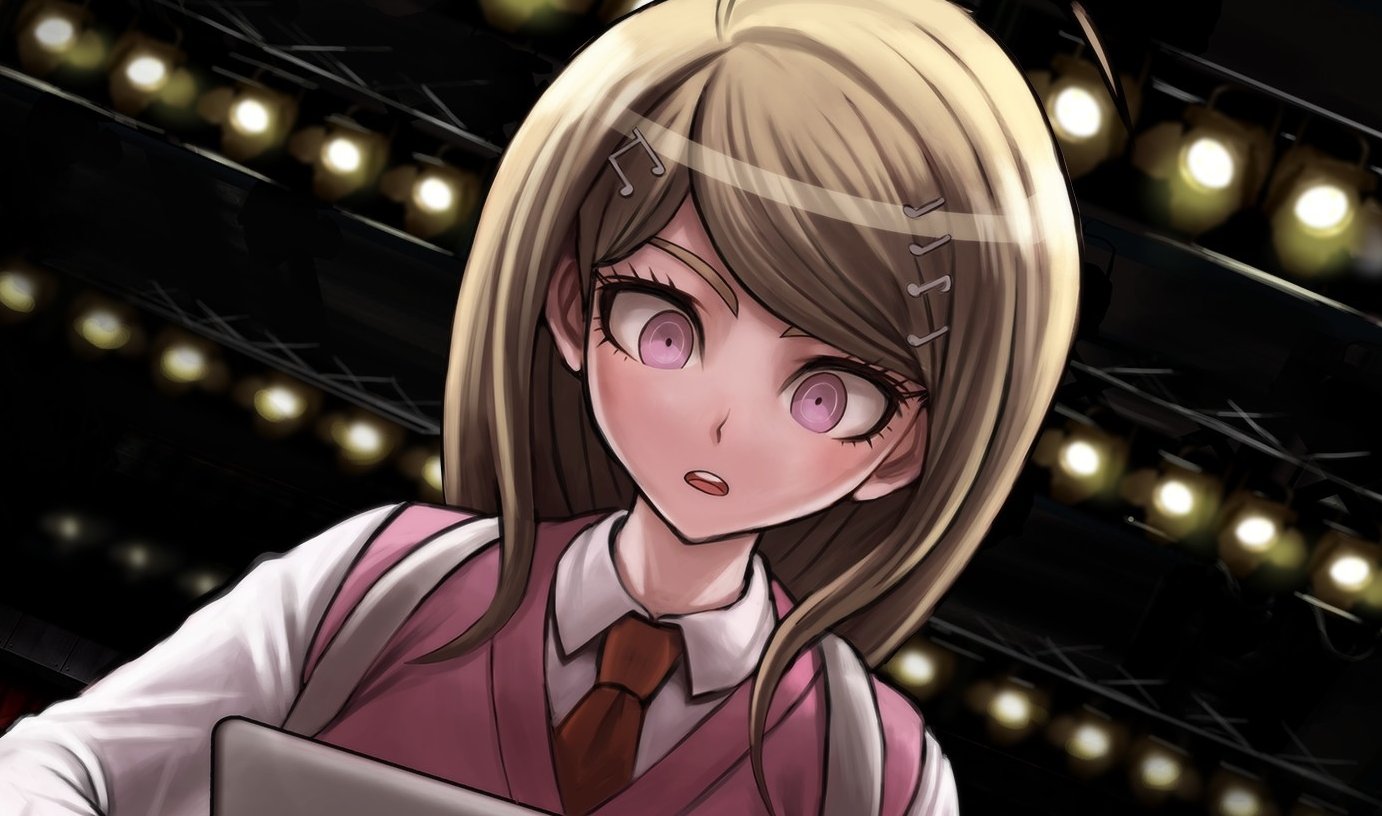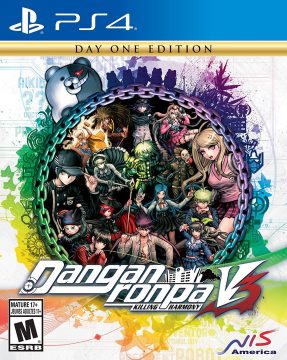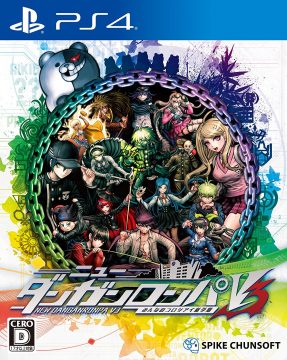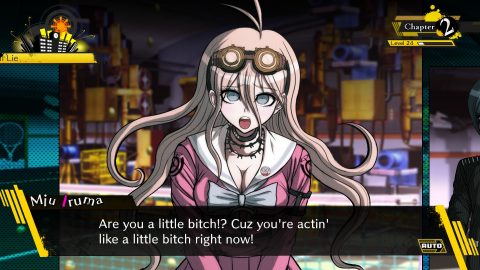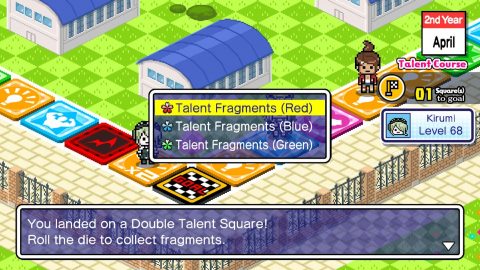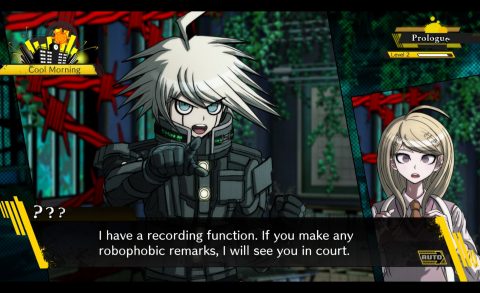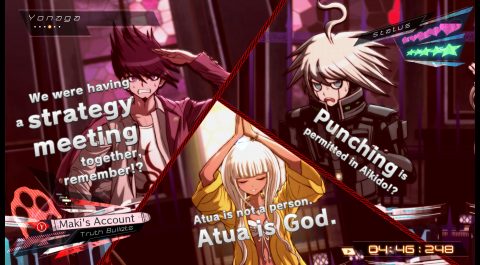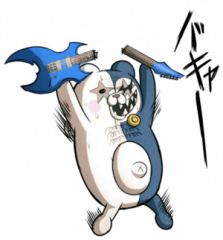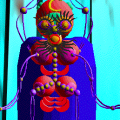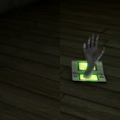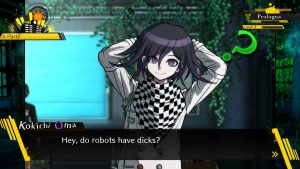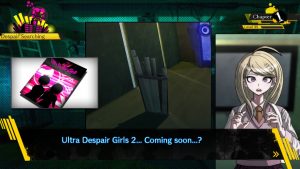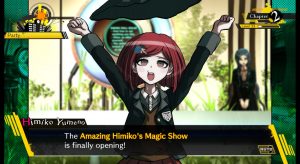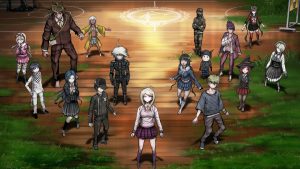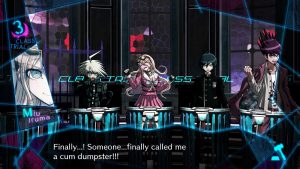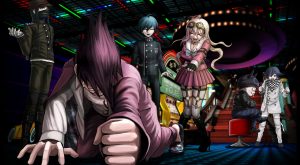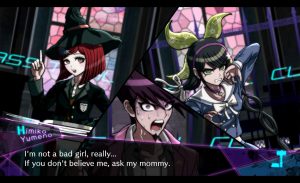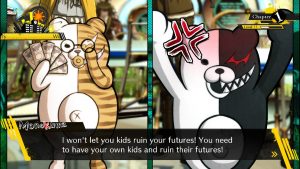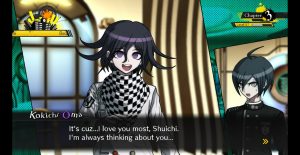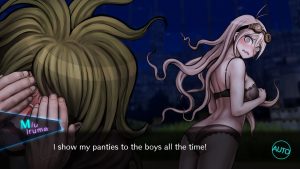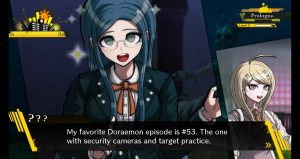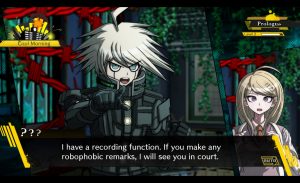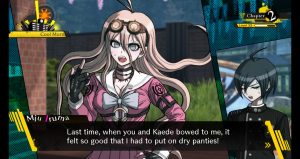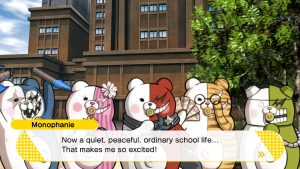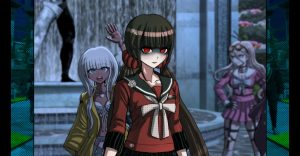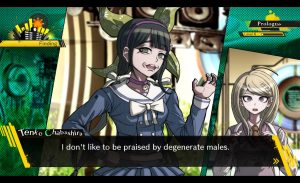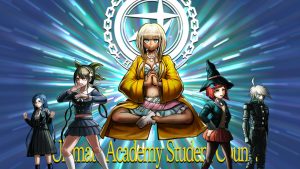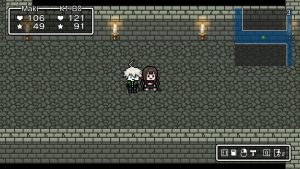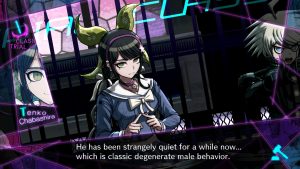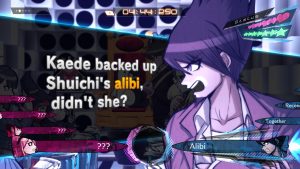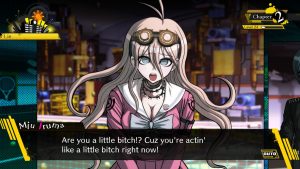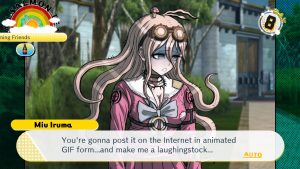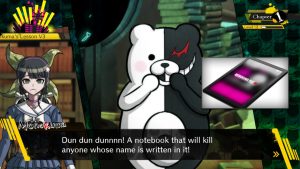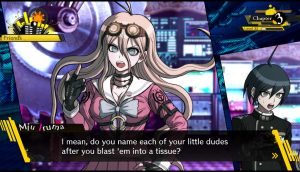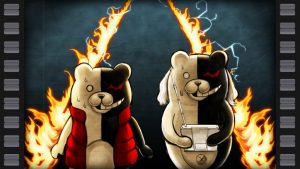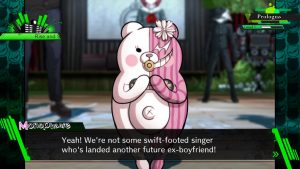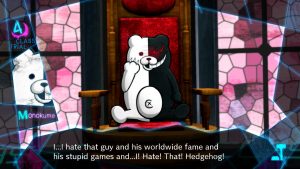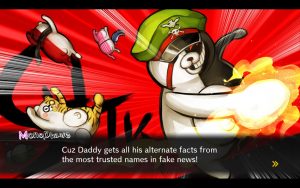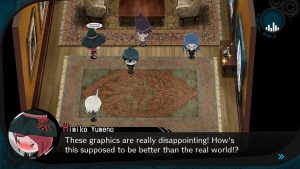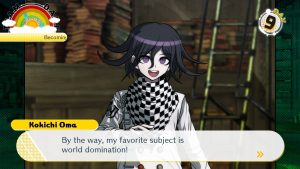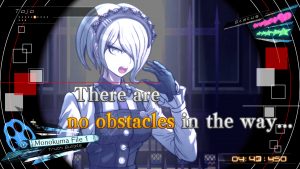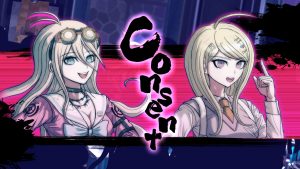While the Danganronpa 3 anime wrapped up the main plots from the first two games, Danganronpa V3 (confusing name, yes) is the actual third game in the series, purportedly divorced from the baggage of all of the others. Yet, the premise is still familiar, especially as it returns to the school setting (and solely first person exploration) of the first Danganronpa. Of course, not everything is quite the same – while still an academy, the place is set up less like a prison, and you’re allowed to walk around the school grounds, which contain lots of unusual places like a casino and a love hotel. As you progress through the chapters, each character gets their own laboratory too, associated with their Ultimate Talent. While these only occasionally have any real effect on the story or cases, it does act to flesh them out.
Indeed, the roster is just as over-the-top and goofy as the second game, with the standouts being the pint-sized nihilistic tennis player/murderer Ryoma Hoshi, the Lennie Small-esque gentle giant (and insect enthusiast) Gonta Gokuhara, and foul mouthed inventor Miu Iruma. Newly introduced are the Monokuma Kubs, more variations on the bear-type characters we’ve seen in previous games. These are actually supposed to be Monokuma’s kids though, and they often act as storytelling devices in his stead, as he seems to lie more in the background than previous games. (His voice actor also seems to be channeling Mickey Mouse more than the other ones, too, perhaps in an effort to replicate the Doraemon connection that was otherwise lost to non-Japanese speakers.) However, the Monokuma Kids usually have way too much dialogue for whatever point their trying to convey, and they usually aren’t humorous enough for the amount of time it takes to get through their dialogue, so it feels like the pacing comes to a halt whenever they show up.
Among the activities in the casino are arcade games, all based on the mini-games found in the trials, exchanged for coins. In addition to the usual gifts, you can also get a ticket to that love hotel (“Hotel Kumasutra”), which triggers a non-canon scene where one of the other characters sees the protagonist as their loved ones, with the result ranging from goofy to borderline R-rated (or they would be if they were anything more than just text).
While the first two games were originally developed for the limited power of the PlayStation Portable, this was designed for more powerful machines, with the weakest being the Vita. This gives the opportunity for many more fancier effects, as the text is the debates is now three dimensional, and floats around in creative and enigmatic ways. (In one spot where a character mentions a worm, the actual word “worm” slinks around.) Other aspects of the interface have been polished up, including adding a picture of the protagonist on the right side, and interjecting characters on the left, rather than the camera flipping between whoever’s talking. You can also choose reaction voices for the main character, though this doesn’t actually affect anything.
Again, some of the trial minigames have been tweaked, though not always for the better. The Hangman’s Gambit game is less frustrating, while the Mind Dive snowboarding game is replaced with an OutRun-esque racing game called Psyche Taxi. This looks cool, particularly with the neon visuals, but they also drag on way too long. New is the Mind Mine, where you crack open blocks of similar colors (which in turn flips the colors of surrounding blocks) to reveal various objects that answer a proposed question. There are also Mass Panic Debates, where several characters begin talking at once; you need to concentrate on the correct one to refute, while shooting down any of the (incorrect) arguments that might be louder than the others.
You’re also given the option to lie, which is required in a few cases in order to get the discussion to proceed. (You can tell these scenarios by a slight differentiation in the music.) There are also a few optional, hidden routes where you can get different dialogue if you lie in certain places, though it doesn’t change much of anything. Apparently it was originally conceived that you could use this option to shortcut though the trials, but this was never actually implemented in the game, probably due to the difficulty in writing such scenarios.
The coolest addition are the Debate Scrums, when opinions are split neatly among divided lines, where the cast is elevated into the sky and must provide specific refutations to each’s argument. It’s fairly simplistic, but it looks cool, and the music is fantastic: a techno dance theme that feels like a follow-up from Masafumi Takada’s brilliant “Rave On” track from Killer7. Though much of the music is elsewhere familiar, it’s still not quite as recycled as Danganronpa 2, and there are tons of new themes.
Also notable is the return of more violent execution scenes. It seems that the writers acknowledged that the punishments of Danganronpa 2 were too…silly and weird, so they go back to being more gruesome, even more so than in the first game.
Danganronpa V3 also has an expansive post game, split into four types. Love Across the Universe is the equivalent to the School/Island Modes of the last two (though without any resource gathering elements), as the setting is changed from a killing game to a dating game, and you’re given ten days to find romance with someone else. These are expanded with additional “date” events once you’ve maxed out their Free Time Events. (This is called Dangan Red Salmon Gang mode in the Japanese version, in a reference to a game show called Neruton Red Whale Gang.)
The other three modes are intrinsically linked together. Card Death Machine gives cards based on various characters across all three games, which are in turn used for the remaining mode. Ultimate Talent Development Plan is a board game/simulation, where you roll dice and land on various squares to increase your chosen character’s statistics and levels, and strengthen relationships with others to gain new skills. And in Despair Dungeon: Monokuma’s Test, you take these trained characters into a dungeon crawler RPG, where you fight in turn-based battles against various Monokuma-like baddies. The best feature of these is the ability to see characters from all three titles interact with each other in specially written scenes, which provides for some amusing fan service. However, while these are all cool ideas, it takes a long time (and a lot of luck) to level up appropriately, and ultimately there’s too much grinding for this to be much fun.
The previous Danganronpa games also had demos that were only released in Japan, which deviated slightly from the actual game, as to not spoil anything. Danganronpa V3 marks the first time where the game’s demo was localized into English. Here, the heroine Kaede meets with the heroes of the previous two games, to ease into the role of the star, while introducing the mechanics of the class trials (and featuring a different victim than the actual game).
Without revealing anything too specific, Danganronpa V3 generally maintains the quality of its predecessors, particularly with the fun roster of characters. It balances some of the darker aspects of the first game with the more surreal aspects of the second, finding a good medium between them. Incidentally, despite initially presenting itself as a soft reboot, it does indeed reference events, characters, and endings from the first two games, so it can’t be played out of order.
However, there are some cracks showing in the formula, as there’s only so much you can do with it before it comes predictable, and both certain cases and certain characters are a little too similar to previous games. This is especially the case with the labs introduced in each new section of the game, because they’re usually involved with that chapter’s murder. The actual cases are fine, with one of the most amusing being the fourth one, which takes place in an RPG-style virtual world. But, as with before, there are still plenty of instances where something is obvious (in this case, particularly to those with even cursory knowledge of old video games) but it takes a long time for the characters to reach the proper conclusion. These have always been problems inherit with the formula of Danganronpa and other similar games, though.
That being said, there are two major aspects that play a big part on this game’s quality (and reception) and it’s impossible to discuss them without delving into spoilers.
As with Ultra Despair Girls, the maximum Vita cart size didn’t have space for Japanese voices, so these are available as free DLC. Similarly, the sound quality of the English voices is noticeably compressed, with higher quality versions available to download for free. The issues also impact the movies, which have substantial compression artifacts. These issues don’t affect the other versions of the game. Otherwise, the Vita version is just fine. The vocal ending theme, “Dun Kusai -break-“ by series regular Megumi Ogata, was unfortunately removed for the overseas release, likely due to licensing issues. It is odd though, considering the vocal song to the previous releases were left intact.
Characters
Kaeae Akamatsu – Ultimate Pianist
The main heroine, whose chipper personality and belief in hope compel her to try to put an ending to the Killing Game
Shuichi Saihara – Ultimate Detective
A shy young man who works for his uncle’s detective agency, whose lack of confidence stems from the ugliness that truth can reveal, especially in the private detective profession.
Gonta Gokuhara – Ultimate Entomologist
Gonta was lost in the woods as a kid for about a decade, where he was basically raised by wolves. He rejoined human society with an obsession with bugs but suitably lower than average intelligence. He seems large and intimidating, but he’s aware of his stature and just wants to be seen as a gentleman.
Miu Iruma – Ultimate Inventor
A genius inventor whose talents (and attractiveness) have not only given her extraordinary arrogance but also an extremely foul mouth. When she’s not demeaning her classmates (especially the fellow girls), she makes lewd jokes and other completely inappropriate comments, though she folds like paper whenever anyone talks back to her.
Himiko Yumeno – Ultimate Magician
A short girl in a witch’s hat who insists that her tricks are actually real magic. Her main spells are hexes of inconvenience, like the things you just purchased going on sale the next day.
K1-B0 – Ultimate Robot
A robot who, in spite of seemingly advanced AI, seems to have been created with slightly outdated technology, like recording sound on tape. He’s quite self-aware and takes offense to “robophobic” remarks from his classmates which designate him as less than human. Nicknamed “Keebo”, which can also be interpreted as the Japanese word “kibou”, meaning “hope”.
Kaito Momota – Ultimate Astronaut
An upbeat student who hasn’t technically been to outer space, but seeks to train every day to obtain his one true dream.
Kirumi Tojo – Ultimate Maid
A kindly young woman of professional stature who acts as sort of a surrogate mother for the rest of the class.
Kokichi Oma – Ultimate Supreme Leader
Kokichi sees himself as James Bond villain, though he’s really just more of a prankster. Still, his desire for mischief causes lots of problems during trials, effectively presenting him as the in-class antagonist, much like Nagito Komaeda from Danganronpa 2.
Korekiyo Shinguji – Ultimate Anthropologist
A rather freaky dude who hides his face with a mask, and is obsessed with world folklore.
Maki Harukawa – Ultimate Child Caregiver
An icy cold young woman with a universally cold glare. She hates children but they seem to be drawn to her, since she spent her younger days in an orphanage. Nicknamed “Maki Roll” by the rest of the class, her catchphrase is “Do you want to die?”
Rantaro Amami – Ultimate ???
Like the heroes of the past games, Rantaro can’t remember what his talent is…except he’s not the protagonist this time around.
Ryoma Hoshi – Ultimate Tennis Pro
Ryoma is the shortest member of the class, at just under three and a half feet. He used to be a world class tennis player, until he used his talents for murder and ended up as a prisoner. He has a cynical wordview but seems to have accepted his fate at the school.
Tenko Chabashira – Ultimate Aikido Master
A martial artist who is also a misandrist (“Degenerate male!”, she cries with regularity, at the most innocuous provocation). In spite of her untrustworthy attitude towards men (and general loudness), she’s helpful and caring towards women, particularly Himiko. She has a large green bow in the shape of a shuriken.
Tsumugi Shirogane – Ultimate Cosplayer
A meek girl with a huge talent for dressing up as characters from anime and video games. She often drops in references to various shows, perplexing those who aren’t as big into nerd things as she is.
Angie Yonaga – Ultimate Artist
A peppy blond haired, tanned girl from an unnamed (probably Polynesian) island. She is talented in many fields of art, but sees herself only as a vassal for her god, Atua, who she worships in furvor and eagerly pushes on everyone.
Monokuma Kubs: Monotaro, Monosuke, Monodam, Monokid, Monophanie (Monofunny)
Monokuma’s five children, although they are plush robots just like him. He alternates between affection and annoyance at their antics. They pilot the Exisal mechas that patrol the school, and deliver the morning/nighttime announcements. It’s clear that they were given too much responsibility because their screw-ups throughout the game’s plot are noticeable.
